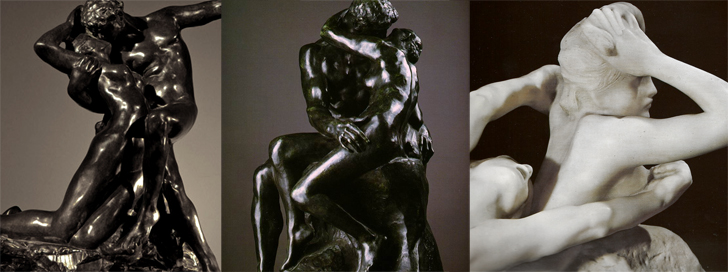The eroticism of Rodin
Posted by AV Flox on Dec 21st 2016


When people think of Auguste Rodin, they imagine The Thinker, perhaps even his famous Gates of Hell. But anyone who has walked among his sculptures, even those figures that started as designs for what would become the portal depicting Dante's Inferno, such as Eternal Springtime, The Kiss, Fleeting Love, and Paolo and Francesca, would find it difficult to deny their eroticism despite their association with eternal damnation. Indeed, despite Rodin's love of Dante, the famous work served as a spectacular vehicle for the artist's interest in the erotic. The word "springtime" in one of those works clearly communicates the intent -- Rodin, like many artists in the 1870s, was a fan of Japanese art, in particular the explicit prints called shunga, or "picture of spring."
The eroticism in his work made the French sculptor controversial but Rodin loved the female body, both admiring it and depicting it. He enjoyed showing women not as nimble creatures being taken by men, but as participants in their own right, in possession of their sexuality. And it wasn't simply the female body which scandalized the French public. In 1883, his sculpture Age of Bronze, which shows a nude young man, caused something of a sensation. It was reviewed by the French newspaper L'Intransigeant, which said, "this slim, standing youth has all the raw grace of primitive times in which a creature would display himself with no care for civilized modesty."
The France we imagine, full of sex of licentiousness, was not the France in which Rodin lived. The French Revolution was as much about changing the structure of society as it was about doing away with its immorality. The Empire and Restoration continued the march against debauchery and indecency. The director of the Department of Fine Arts even complained to Charles X about the state of the Louvre, saying, "Decency is offended, parents scarcely dare take children of either sex through the rooms of antiquities, and girls interested in the arts must stop themselves from contemplating and studying the finest models if they have not lost all sense of modesty."
Things did not change after the Second French Revolution in 1830. In fact, the famous work now most strongly associated with that revolt -- Liberty Leading the People by Eugène Delacroix, which shows part of a woman's breast -- was widely considered at the time to be completely antithetical to the French idea of liberty. The French newspaper Le Moniteur Universel tore it apart, saying, "This characterless head, this half-naked body, this deformed bosom with its faded flesh -- surely none of these things correspond to the concept of the painter or to the idea that we have of the fine and noble liberty that triumphed on 29 July."
During the reign of Louis-Philippe I, the Bibliothèque Royale began listing all books deemed morally repugnant. In 1857, the author Gustave Flaubert faced charges of "offending public morals" over his book Madame Bovary. Thirty years later, a moral panic involving masturbation, best illustrated by Pierre Garnier's Onanism Alone And In Pairs In All Its Forms and Their Consequences, erupted. But none of this stopped Rodin, who -- when not sculpting -- was busy sketching and painting women reclining, their legs spread, many of them caressing themselves. It is these less well-known works are some of Rodin's most revealing in terms of his interest in the erotic.
The Erotic Art online gallery and the Musée Rodin have a number of his watercolors and drawings, which are well worth the look. One of them, Study of a Woman Nude, Standing, Arms Raised, Hands Crossed Above Head, was recovered from Cornelius Gurlitt, who was found in 2014 of being in possession of a number of artworks looted by the Nazis during World War II for being "degenerate."

